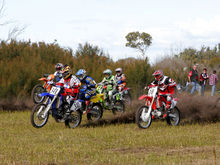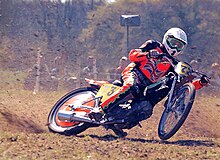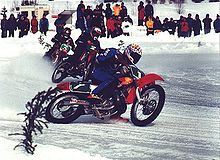This is an old revision of this page, as edited by TutterMouse (talk | contribs) at 13:36, 27 May 2010 (Reverted edits by 217.33.74.20 (talk) to last revision by ClueBot (HG)). The present address (URL) is a permanent link to this revision, which may differ significantly from the current revision.
Revision as of 13:36, 27 May 2010 by TutterMouse (talk | contribs) (Reverted edits by 217.33.74.20 (talk) to last revision by ClueBot (HG))(diff) ← Previous revision | Latest revision (diff) | Newer revision → (diff)| File:Lydden05.jpgTwo motorcycles racing at Lydden | |
| Highest governing body | FIM |
|---|---|
| First played | November 29, 1895 |
| Characteristics | |
| Mixed-sex | Yes |
| Type | Outdoor |
Motorcycle racing (also known as moto racing (short term) and bike racing (common term)) is a motorcycle sport involving racing motorcycles.
Categories
The FIM classifies motorcycle racing in the following four main categories. Each category has several sub categories.
Road racing

Road racing is the racing of motorcycles on tarmac. Races can take place either on purpose-built racing circuits or on closed public roads.
Motorcycle Grand Prix

Grand Prix motorcycle racing refers to the premier category of motorcycle road racing. It is divided into three distinct classes: 125 cc, 250 cc and 800 cc MotoGP. Grand prix motorcycles are prototype machines not based on any production motorcycle. Dorna Sports, MotoGP's parent company, has announced that the 250 cc class will be replaced with a 600 cc class in 2010.
Superbike racing

Superbike racing is a category of motorcycle road racing that employs modified production motorcycles. Superbike racing motorcycles must have four stroke engines of between 800 cc and 1200 cc for twins, and between 750 cc and 1000 cc for four cylinder machines. The motorcycles must maintain the same profile as their roadgoing counterparts. The overall appearance, seen from the front, rear and sides, must correspond to that of the bike homologated for use on public roads.
Supersport racing

Supersport racing is another category of motorcycle road racing that employs modified production motorcycles. To be eligible for Supersport racing, a motorcycle must have a four-stroke engine of between 400 and 600 cc for four-cylinder machines, and between 600 and 750 cc for twins, and must satisfy the FIM homologation requirements. Supersport regulations are much tighter than Superbikes. Supersport machines must remain largely as standard, while engine tuning is possible but tightly regulated.
Endurance racing

Endurance racing is a category of motorcycle road racing which is meant to test the durability of equipment and endurance of the riders. Teams of multiple riders attempt to cover a large distance in a single event. Riders are given the ability to change during the race. Endurance races can be run either to cover a set distance in laps as quickly as possible, or to cover as much distance as possible over a preset amount of time.
Sidecar racing

Sidecar racing is a category of sidecar motorcycle racing. Older sidecar road racers generally resembled solo motorcycles with a platform attached, modern racing sidecars are purpose built low and long vehicles. Sidecarcross resembles MX motorcycles with a high platform attached. In sidecar racing a rider and a passenger work together to make the machine perform.
Sidecar racing has many sub-categories including: - Sidecarcross (sidecar motocross) - Sidecar trials - F1/F2 road racing
True road racing

True road racing is run on tracks built from closed public and/or park roads and sometimes extra pieces of purpose built track. In the past true road racing was very commonplace but today only few races have survived and even fewer have been added. Only one truly international championship exists at present by the name of "International Road Racing Championship" (IRRC). Most races are held within Europe. Ireland is probably the country with the most true road racing circuits still in use. The Isle of Man probably has the most tracks per inhabitant or surface area. Other countries where true road races are held are the Netherlands, Belgium, Germany, Great Britain, though due to law only outside England or in parks, the Czech Republic, New Zealand and Macau
See also: Isle of Man TT See also: North West 200Motocross

Motocross (or MX) is the direct equivalent of road racing, but off road, a number of bikes racing on a closed circuit. Motocross circuits are constructed on a variety of non-tarmac surfaces such as dirt, sand, mud, grass, etc., and tend to incorporate elevation changes either natural or artificial. Advances in motorcycle technology, especially suspension, have led to the predominance of circuits with added "jumps" on which bikes can get airborne. Motocross has another noticeable difference from road racing, in that starts are done en masse, with the riders alongside each other. Up to 40 riders race into the first corner, and sometimes there is a separate award for the first rider through (see holeshot). The winner is the first rider across the finish line, generally after a given amount of time or laps or a combination.
Motocross has a plethora of classes based upon machine displacement (ranging from 50cc 2-stroke youth machines up to 250cc 2-stroke and 450cc 4-stroke), age of competitor, ability of competitor, sidecars, quads/ATVs, and machine age (classic for pre 1965/67, Twinshock for bikes with two shock absorbers, etc).
Supercross
Supercross (or SX) is simply indoor motocross. Supercross is more technical and rhythm like to riders. Typically situated in a variety of stadiums and open or closed arenas, it is notable for its numerous jumps. In North America, this has been turned into an extremely popular spectator sport, filling large baseball stadiums, leading to Motocross being now termed the "outdoors". However, in Europe it is less popular, as the predominate focus there is on Motocross.
Supermoto
Supermoto is a racing category that is a crossover between road-racing and motocross. The motorcycles are mainly motocross types with road-racing tyres. The racetrack is a mixture of road and dirt courses (in different proportions) and can take place either on closed circuits or in temporary venues (such as urban locations).
The riding style on the tarmac section is noticeably different from other forms of tarmac-based racing, with a different line in corners, sliding of the back wheel around the corner, and using the leg straight out to corner (as opposed to the noticeable touching of the bent knee to the tarmac of road racers).
Enduro and Cross-country
Enduro

Enduro is a form of off road motorcycle sport that primarily focuses on the endurance of the competitor. In the most traditional sense ("Time Card Enduros"), competitors complete a 10+ mile lap, of predominately off road going, often through forestry. The lap is made up of different stages, each with a target time to complete that stage in exactly, there are penalties for being early and late, thus the goal is to be exactly "on time". Some stages are deliberately "tight", others are lax allowing the competitor to recuperate. There are also a variety of special tests, on variety of terrain to further aid classification, these are speed stages where the fastest time is desired. A normal event lasts for 3 to 4 hours, although longer events are not uncommon. Some events, particularly national and world championship events take place over several days, requiring the competitors motorcycles to kept securely and thus any maintenance work has to be carried out within a very limited window of time or during the event.
There is a World Enduro Championship (WEC) that has events across Europe, with a few excursions to North America. The most significant event in the Enduro calendar is the International Six Day Enduro ISDE (formerly the ISDT), where countries enter teams of riders (i.e. Enduro's "World Cup"), as well as club teams - the event combines amateur sport with the professional level sport, it also takes place in a much more geographically dispersed range of locations.
In addition to traditional Time Card Enduros held over a long lap, a variety of other forms of sport have been taken up; notably "Short Course Enduros", a shorter (in lap length) form of Time Card Enduros Hare scrambles and "Hare and Hounds".
Hare scramble
Main article: Hare scramble
Hare scramble is the name given to a particular form of off-road motorcycle racing. Traditionally a hare scramble can vary in length and time with the contestants completing multiple laps around a marked course through wooded or other rugged natural terrain. The overall winner is awarded to the contestant who maintains the highest speed throughout the event.
Cross-Country Rally
Main article: Rally raidCross-Country Rally events (also called Rallye Raid or simply Rallye, alternate spelling Rally) are much bigger than enduros. Typically using larger bikes than other off road sports, these events take place over many days, travelling hundreds of miles across primarily open off road terrain. The most famous example is the Dakar Rally, travelling from Western Europe (often Paris) to Dakar in Senegal, via the Sahara desert, taking almost two weeks. A FIM World Rally championship also exists encompassing many events across the world, typically in desert nations. These events often run alongside "car" rallys (under the FIA).
Track racing

Track racing is a form of motorcycle racing where teams or individuals race opponents around an oval track. There are differing variants, with each variant racing on a different surface type.
Indoor Short Track and TT Racing
Indoor races consist of either a polished concrete floor with coke syrup or other media sprayed or mopped onto the concrete for traction for the tyres of the motorcycles, or on dirt that has been moistened and hard packed, or left loose (often called a cushion). Motorcycles race on an oval track, or over a single jump with a right hand turn called a TT track. Similar to size of the Arenacross Arenas or sometimes smaller the riders must have accurate throttle control to negotiate these tight Indoor Race Tracks.
In the U.S., Short Track and TT events are more commonly held outdoors. A Short Track event is one involving a track of less than 1/2 mile in length, a TT event can be of any length, but it must have at least one right turn and at least one jump.
In the U.S., Short Track and TT races are part of a specific discipline labelled "Dirttrack" or sometimes "Flattrack" (also called Flat Track). However the AMA Sanction rule books refer to this discipline as Dirttrack racing. Whether Short Track or TT, traction is what defines a dirttrack race. The bikes cannot use "knobbies", they must use "Class C" tires which look a lot like street tires. On a Short Track course, the track is an oval, all turns to the left only, and only a rear brake is allowed. On the TT courses, as mentioned above, there must be at least one right hand turn a jump is optional, a front brake is allowed, but the same "Class C" tires are required. Although not mandated, most flattrack racers wear a steel "shoe" on the left boot which is actually a fitted steel sole that straps onto the left boot. This steel shoe lets the rider lean the bike to the left while sliding through the corners.
Hard-packed tracks are generally referred to as "groove" tracks, loosely-packed tracks are called "cushions".
Web Site for one Indoor Racing Sanction is http://ampown.com
One webpage for a flattracking club is http://www.lodicyclebowl.com
One webpage for this form of racing is http://flattrack.com
Speedway

Speedway racing takes place on a flat oval track usually consisting of dirt or loosely packed shale. Competitors use this surface to slide their machines sideways (powersliding or broadsiding) into the bends using the rear wheel to scrub-off speed while still providing the drive to power the bike forward and around the bend.
Grass Track

Grasstrack is "outdoor" speedway. The track are longer (400 m+, hence it is often also refereed to as Long Track at world level), often on grass (although other surfaces exist) and even feature elevation changes. Machinery is very similar to a speedway bike (still no brakes, but normally two gears, etc).
Ice Speedway

Ice racing includes a motorcycle class which is the equivalent of Speedway on ice. Bikes race anti-clockwise around oval tracks between 260 and 425 metres in length. The race structure and scoring are similar to Speedway.
Board track

Board track racing was a type of track racing popular in the United States between the second and third decades of the 20th century, where competition was conducted on oval race courses with surfaces composed of wooden planks. By the early 1930s, board track racing had fallen out of favor, and into eventual obsolescence.
Auto Race

Auto Race is a Japanese version of track racing held on an asphalt oval course and seen as a gambling sport.
Other categories
Drag Racing / Sprints

Drag racing and/or sprints is a racing venue where two participants line up at a dragstrip with a signaled starting line. Upon the starting signal, the riders accelerate down a straight, quarter-mile long paved track where their elapsed time and terminal speed are recorded. The rider to reach the finish line first is the winner. This can occur upon purpose built venues (e.g., Santa Pod), temporary venues (e.g., runways or drives of country houses). In addition to "regular" motorcycles, top fuel motorcycles also compete in this category.
Hill Climb
Main article: HillclimbingIn hill climbing, a single rider climbs or tries to climb a road going up a hill in the fastest time and/or the furthest up the hill before ceasing forward motion. Tarmac events are typically on closed public roads and private roads. The same concept is also used off-tarmac, usually on steeper hills.
Landspeed Racing
Main article: Motorcycle land speed recordIn Landspeed motorcycle racing, the racer is trying to beat the fastest speed ever achieved by that style of motorcycle and type of engine for a timed mile. The pre-eminent event for motorcycle LSR is the International Motorcycle Speed Trials by BUB, held on the Bonneville Salt Flats annually (near Labor Day.) Motorcycles are classified based on body style, i.e. how much streamlining is incorporated. They are further classified based on engine size in cubic centimeters (cc's) and based on fuel type (gasoline versus any modified fuel.)
Vintage Motorcycle Racing
In vintage racing riders race classic motorcycles that are no longer competitive with the latest production motorcycles. Classes are organized by production period and engine displacement. There are vintage events for almost every type of racing listed above, vintage motocross and road racing are especially popular. Equipment is limited to that available for the production period, although modern safety equipment and tires are permitted. Most vintage production periods are from the 1970s and before, but now 1980s motorcycles are being allowed into some events. Generally a motorcycle must be at least 25 years old to be considered vintage.
The sanctioning body for most US vintage racing is the American Motorcyclist Association. The main organizations that sponsor vintage racing are the American Historic Racing Motorcycle Association (AHRMA), and WERA Motorcycle Roadracing, which has several vintage classes along with modern racers. Of historical importance is the United States Classic Racing Association (USCRA) one of the oldest vintage racing clubs in the US.
See also
References
- "Fédération Internationale de Motocyclisme". Fim.ch. Retrieved 2009-03-28.
External links
Sanctioning bodies
- Fédération Internationale de Motocyclismo (FIM) - World governing body
- Motorcycling Australia (MA)- Australian Governing Body
- Auto Cycle Union - UK governing body
- Supercross Motorcycle Racing - Worldwide Supercross Motorcycle Racing
- American Motorcyclist Association (AMA) - US governing body
- Motosport South Africa (MSA) - South African governing body
- Federation Francaise de moto (FFM) - French governing body
- MCUI Southern Centre - "governing body of motor cycle sport in Leinster, Munster and Connacht" (i.e., Republic of Ireland)
- Championship Cup Series - Sanctioning Body for Sportsman Level motorcycle road racing in the United States
Misc
- Racesafe, British Superbike Marshals' organisation
- Motorcycle-Glossary.com Motorcycle Glossary.
- 300 curves of Gustav Havel - traditional road race in Horice, Czech Republic. Also known as Czech Tourist Trophy. News, photos, videos, riders
- Choosing a Motorcycle Racing Suit
- Motorcycle Racing News Motorcycle Racing News.